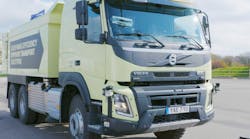Autonomous vehicles certainly seem all the rage right now, especially when it comes to developing self-driving trucks to haul freight, as the video below shows.
Of course, the use of autonomous vehicles is not limited to just the freight-hauling business. Indeed, the mining industry is hard at work seeking ways to deploy self-driving technology, too.
“Automation is an exciting field of technology where advances are moving quickly. Solutions already exist and we expect to see more autonomous solutions in the future,” noted Martin Lundstedt, president and CEO of the Volvo Group, in a recent missive, and his company is now hard at work commercializing self-driving capability for construction trucks.
A new cooperative venture between the Volvo Group and Saab – through its wholly owned technology consulting company Combitech – seeks to develop a fully autonomous transport system solution that can navigate and operate itself autonomously both above and below ground.
This particular self-driving truck uses sensors and GPS technology to continuously read its surroundings, navigating around both fixed and movable obstacles, all while gathering data via its transport system in order to further optimize its route and traffic safety.
[In an interesting twist, Volvo is also using “robot pilots” to conduct truck safety tests.]
Torbjörn Holmström, Volvo Group’s chief technology officer, noted in a statement that the company’s self-driving construction truck requires no manual supervision, but rather will be “part of the customer’s total transport solution” that ultimately controls a firm’s “entire production process.”
“We’ve been conducting research into autonomous vehicles for several years and we are delighted to have already developed a solution that we believe will ultimately revolutionize the mining industry,” he explained. “We expect to be able to significantly increase our customers’ productivity while at the same time improving fuel efficiency and safety.”
[That’s on top of the latest capability being given to trucks: the ability to diagnose maintenance problems and repair themselves.]
Yet Volvo’s Lundstedt made an interesting point in all of this: that the technologies that allow trucks to operate themselves in large measure already exist, largely via “active safety systems” already offered as options by many truck OEMs.
“Our customers are already benefiting from this technology today since we apply the same principles to our active safety systems,” he pointed out.
Now if they can just get trucks to make coffee and breakfast …



